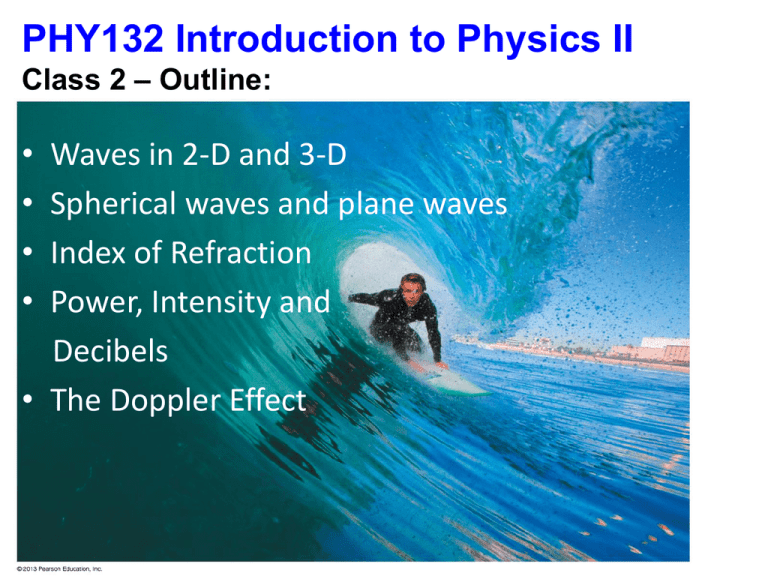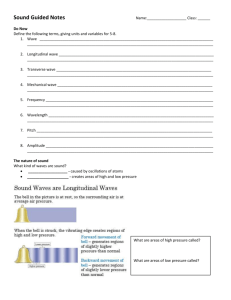Sinusoidal Waves
advertisement

PHY132 Introduction to Physics II Class 2 – Outline: • • • • Waves in 2-D and 3-D Spherical waves and plane waves Index of Refraction Power, Intensity and Decibels • The Doppler Effect Last Time • Mechanical Waves: waves that require a medium • The wave travels through the medium. The wave speed is relative to that medium • Many waves: “transverse” or “longitudinal” • Sinusoidal waves – Source: Simple Harmonic Motion – Periodic in time (period T ) and space (wavelength l) QuickCheck Clicker Question 20.6 1 Sinusoidal Wave Review The period of this wave is A. 1 s. B. 2 s. C. 4 s. D. Not enough information to tell. Sinusoidal Waves As the wave moves along x, the velocity of a particle on the string is in the y-direction. dvy ay = = -w 2 Asin(kx - w t + f0 ) dt Waves in Two and Three Dimensions [Animation courtesy of Dan Russell, Penn State] Waves in Two and Three Dimensions Clicker Question20.8 2 QuickCheck A spherical wave travels outward from a point source. What is the phase difference between the two points on the wave marked with dots? A. B. C. D. E. /4 radians. /2 radians. radians. 7 /2 radians. 7 radians. The Index of Refraction • Light waves travel with speed c in a vacuum, but they slow down as they pass through transparent materials such as water or glass or even, to a very slight extent, air. • The speed of light in a material is characterized by the material’s index of refraction n, defined as The Index of Refraction Clicker Question 20.9 3 QuickCheck A light wave travels, as a plane wave, from air (n = 1.0) into glass (n = 1.5). Which diagram shows the correct wave fronts? Power and Intensity The power of a wave is the rate, in joules per second, at which the wave transfers energy. When plane waves of power P impinge on area a, we define the intensity I to be: Example. A laser pointer emits 1.0 mW of light power into a 1.0 mm diameter laser beam. What is the intensity of the laser beam? Intensity of Spherical Waves If a source of spherical waves radiates uniformly in all directions, then the power at distance r is spread uniformly over the surface of a sphere of radius r. The intensity of a uniform spherical wave is: Intensity and Decibels Human hearing spans an extremely wide range of intensities, from the threshold of hearing at 1 × 1012 W/m2 (at midrange frequencies) to the threshold of pain at 10 W/m2. If we want to make a scale of loudness, it’s convenient and logical to place the zero of our scale at the threshold of hearing. To do so, we define the sound intensity level, expressed in decibels (dB), as: where I0 = 1 1012 W/m2. Intensity and Decibels Clicker Question 4 • A sound level of 10 decibels has 10 times more intensity than a sound level of zero decibels. • A sound level of 20 decibels has ___ times more intensity than a sound level of zero decibels. A. 10 B. 20 C. 50 D. 100 E. 200 Clicker Question 5 • When you turn up the volume on your ipod, the sound originally entering your ears at 50 decibels is boosted to 80 decibels. By what factor is the intensity of the sound has increased? A. 1 (no increase) B. 30 C. 100 D. 300 E. 1000 Doppler Effect • If a sound source is not moving relative to you, you hear the “rest frequency” of the emitted sound. • If the source is moving toward you, you will hear a frequency that is higher than the rest frequency. • If the source is moving away from you, you will hear a frequency that is lower than the rest frequency. • By measuring the difference between the observed and known rest frequencies, you can determine the speed of the source. Doppler Effect [image from http://www.physicsclassroom.com/class/waves/u10l3d.cfm ] Clicker Question 6 Which statement is true? Valerie is standing in the middle of the road, as a police car approaches her at a constant speed, v. The siren on the police car emits a “rest frequency” of f0. A. The frequency she hears rises steadily as the police car gets closer and closer. B. The frequency she hears steadily decreases as the police car gets closer and closer. C. The frequency she hears does not change as the police car gets closer. Clicker Question 7 Which statement is true? Valerie is standing in the middle of the road, listening to the siren of a police car approaching her at a constant speed, v. Daniel is listening to a similar siren on a police car that is not moving. A. The frequency Daniel hears is lower than the frequency Valerie hears. B. The frequency Daniel hears is higher than the frequency Valerie hears. C. The frequencies that Daniel and Valerie hear are exactly the same. The Doppler Effect The frequencies heard by a stationary observer when the sound source is moving at speed v0 are The frequencies heard by an observer moving at speed v0 relative to a stationary sound source emitting frequency f0 are Before Class 3 on Monday • Please read Knight pages 591-603: Ch. 21, sections 21.1-21.4 • Please do the short pre-class quiz on MasteringPhysics by Sunday evening. • Something to think about: What is the difference between a traveling wave and a standing wave. Does a standing wave really stand still?






